Loch Assynt, Ardvreck Castle and Brae of Achnahaird
The life of a photographer means getting up early and being in place at least one hour before dawn, composition primed, camera at the ready. Fortunately for us sunrise in January in the North of Scotland is about 9:45am; we were up and checked out of The Royal Hotel by 7:15am and on the road. Overnight there had been a dusting of snow and then the skies had cleared, the stars sparkled in the morning twilight and the silhouettes of mountains were barely visible. The clear night meant that temperatures had plummeted, as we left the hotel the gauge read -7C.
Preparing for the cold
Although not extreme, it was colder than anything we were used to and we’d be standing outdoors in these freezing temperatures all day. When planning this trip Samantha realised that I had very little in the way of winter clothing; which might be why I’ve traditionally hated the cold so much. For my birthday I had presents that would fix this; from Sam’s mum a set of thermals, from my mum a long sleeved t-shirt, and from Sam some brilliant shooting gloves – brilliant because the “trigger finger” can be folded back using magnets, leaving the finger free to “shoot”, or take pictures in my case. Preparing for today, we layered up. Three pairs of socks and walking boots; thermals, jeans and wet weather trousers; thermals, t-shirt, shirt, jumper, coat; two hats and a pair of gloves. I think Sam had one further layer too. For added warmth bonus I put some of the inner layers on the radiator first – our room was really cold and I couldn’t bring myself to put on cold clothes.
Sunrise over Loch Assynt and Ardvreck Castle
With the sky so clear it might not be so good for sunrise, there’d be nothing for the early light to catch, other than the peaks of the mountains. The original plan was to head to Ardvreck Castle, the 16th century ruins of which overlook Loch Assynt in Sutherland. We set off in that direction, but prepared to change our plans – perhaps to carry on towards the beach, but we were lucky; in the East the sky was clear for the sun to shine through, but importantly, in the West a bank of thick cloud lay still – just beyond the mountains and positioned for the morning light to strike it with all its wondrous pink and purple hues. “This could be spectacular, you might be very lucky”, Ian said. Rather than head behind the castle and shoot a silhouette, we stopped in front of it, near the ruins of the double gabled Calda House.
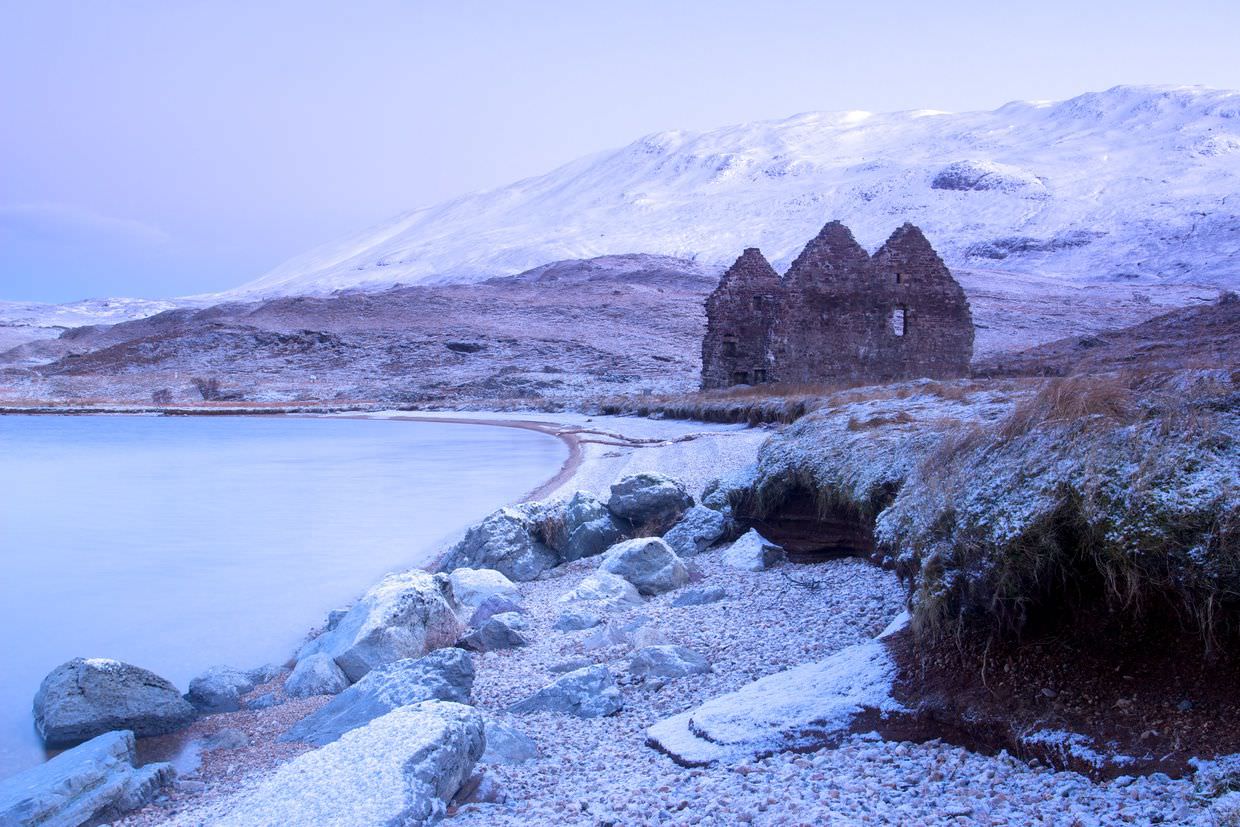
We parked the car, and the three of us headed down towards the beach edge of Loch Assynt. Approaching the scene from behind was doubly important this time, not only would we create footprints in the sand, but we’d disturb the delicate snow that still rested on each and every pebble. Out across the water sat the picturesque ruins of Ardvreck Castle in front of Quinag mountain. Using the gitzo tripods we were borrowing, we searched for a composition; I tried something looking North towards Calda House using the curve of the beach while Sam setup looking across the water with some lovely rocks in the foreground. We were using hard edged filters again, and we paid careful attention to line up the edge with a line in the composition. And then we waited for the earth to spin.
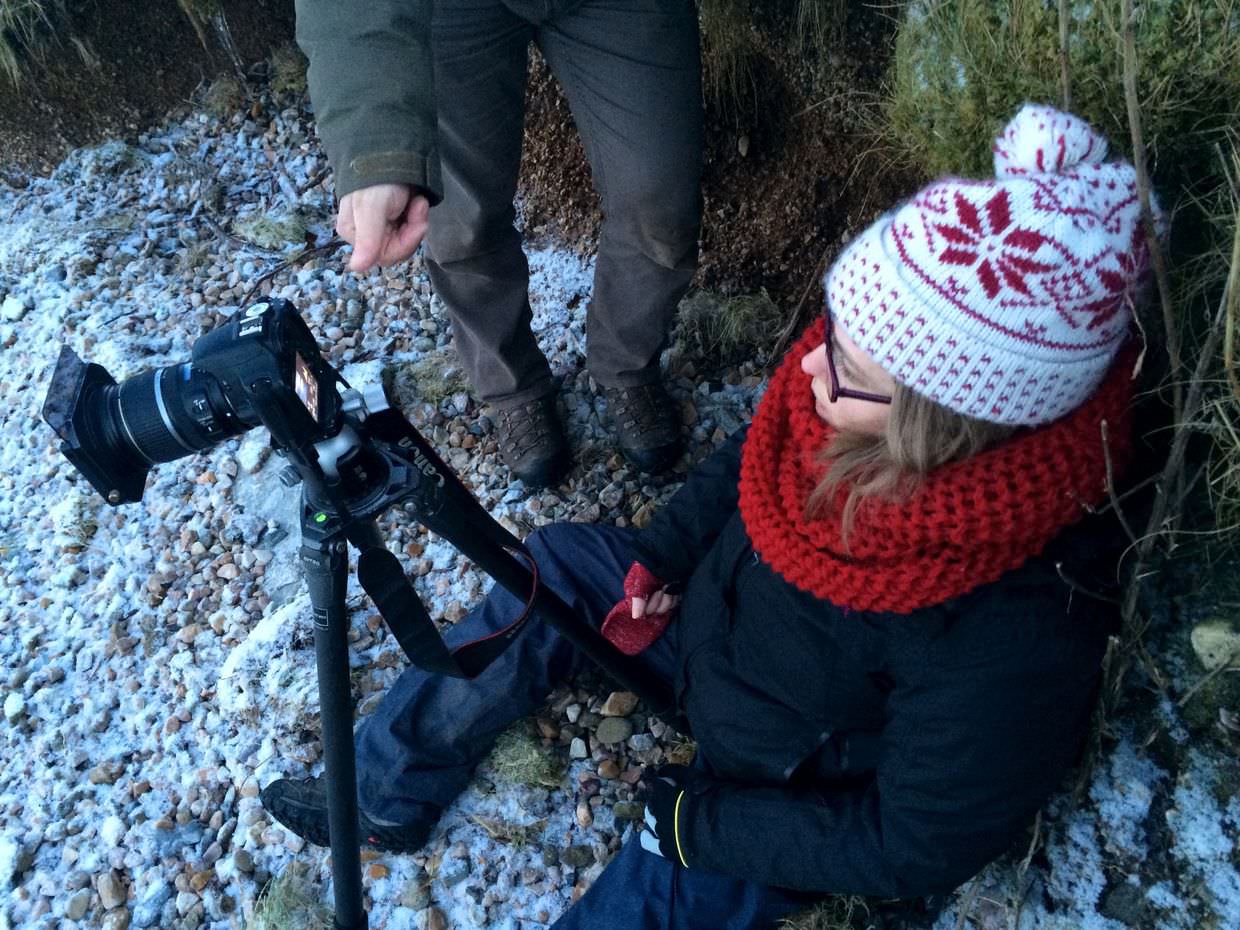
Soon the light began to change, the edges of the clouds started to catch the earliest light and turn a subtle pink. This only grew stronger, and pinker; quickly the cloud edges were a radiant pink, while the undersides turned a deep purple. The loch in front caught the luminous light beautifully, turning a mystical cyan–magenta colour. The most miraculous composition was across the water, and at the last minute I changed view to capture it, just as the pink light caught the white mountaintop. “This is the best I’ve seen this”, Ian said with unbridled excitement, and he was snapping through rolls of fuji film at a time. I returned to my original composition, to capture the double gabled house against the luminous pink landscape, using a 4-stop filter to slow down the shutter speed and smooth out the ripples in the water. And then that light was gone, the pink turned to yellow and the scene totally changed. Yet it remained fascinating, at different times different scenes lit up, sometimes the mountain was in shadow while the castle was bathed in yellow light, or visa versa, at others the castle looked orange, and sometimes it was lost altogether as the same light covered both it and the mountain. It was cold, but it was dry (we couldn’t see our breath) and there was no wind; standing there, watching the light unfold was comfortable, peaceful and beautiful. Where we’d put our bags and lens caps down small ice crystals had formed, and the grasses were weighted down with a layer of frost.
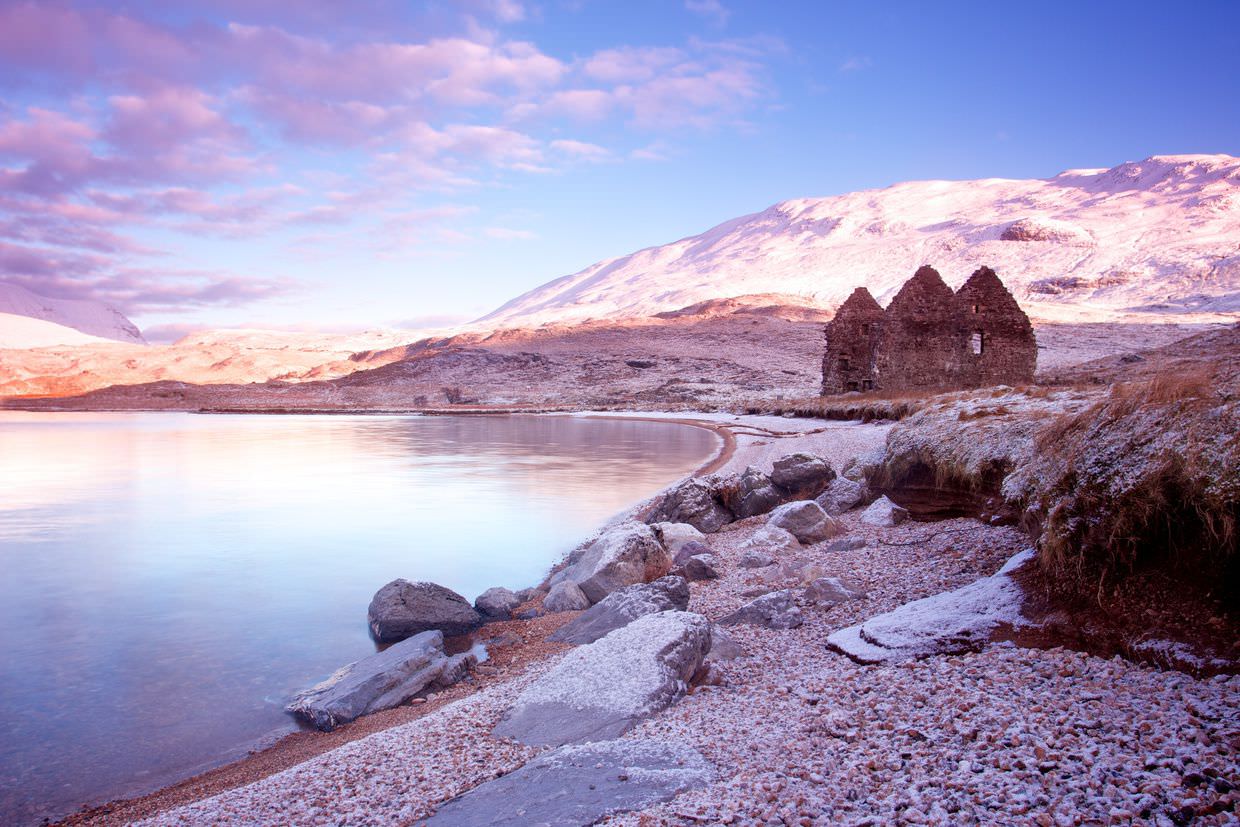

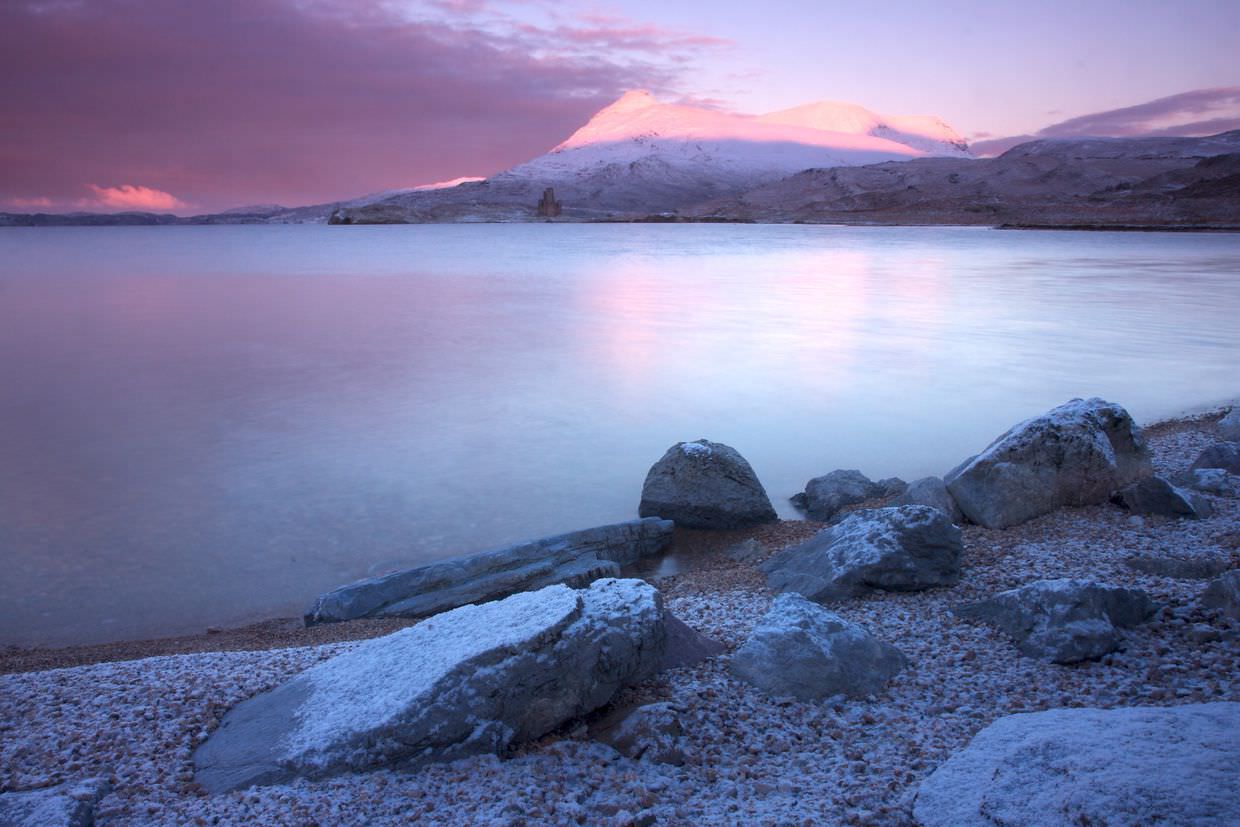
We took lots of pictures. First across the water, then of the house, then more of the castle and some longer exposures with the rocks, then again of the house as the sun came up over the hill – this was a particularly fun one to watch, as the sun cast a gorgeous shadow against the ruins which moved across the front of the building, while also lighting up the grass and a stray branch sticking out into the water. The time slowly crept by without us noticing. Soon enough it was 11:30am, three hours had passed and it was time to drink coffee, eat our packed bacon sandwiches and warm up in the car.
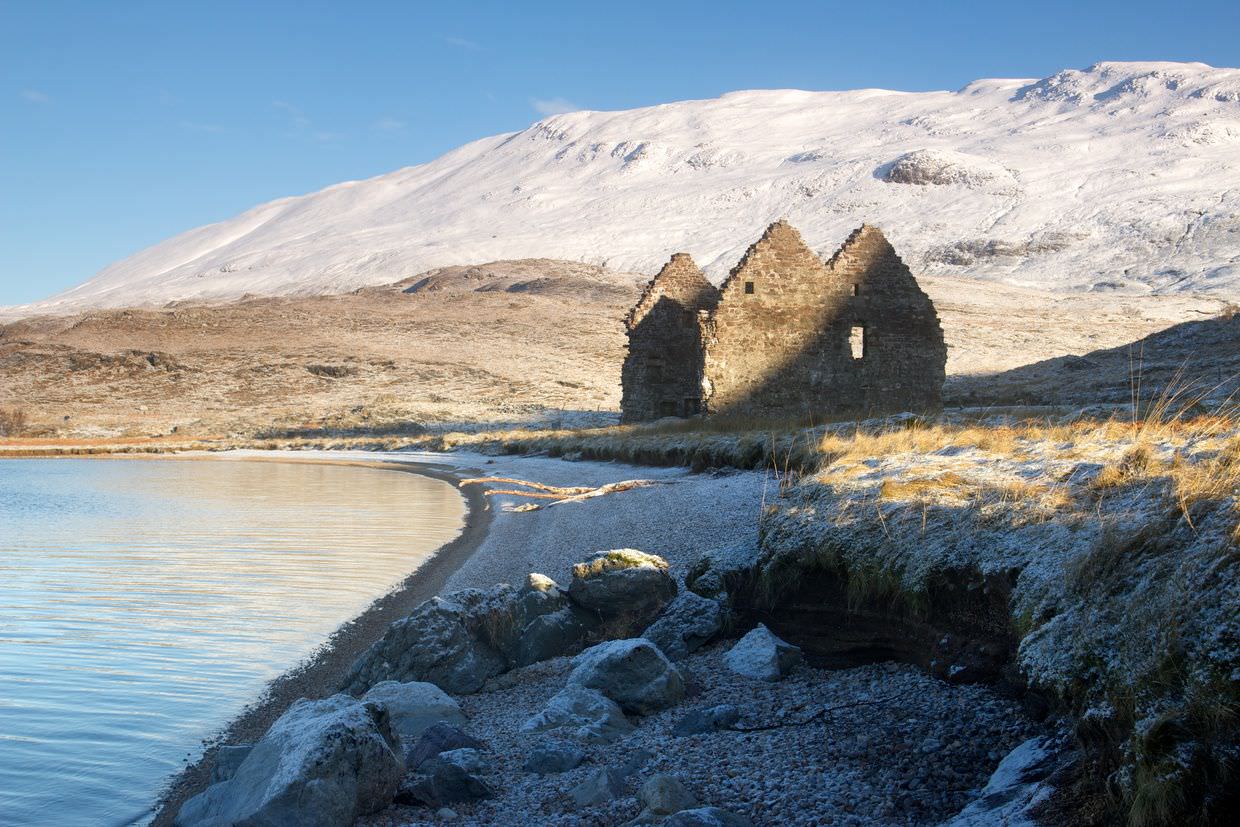
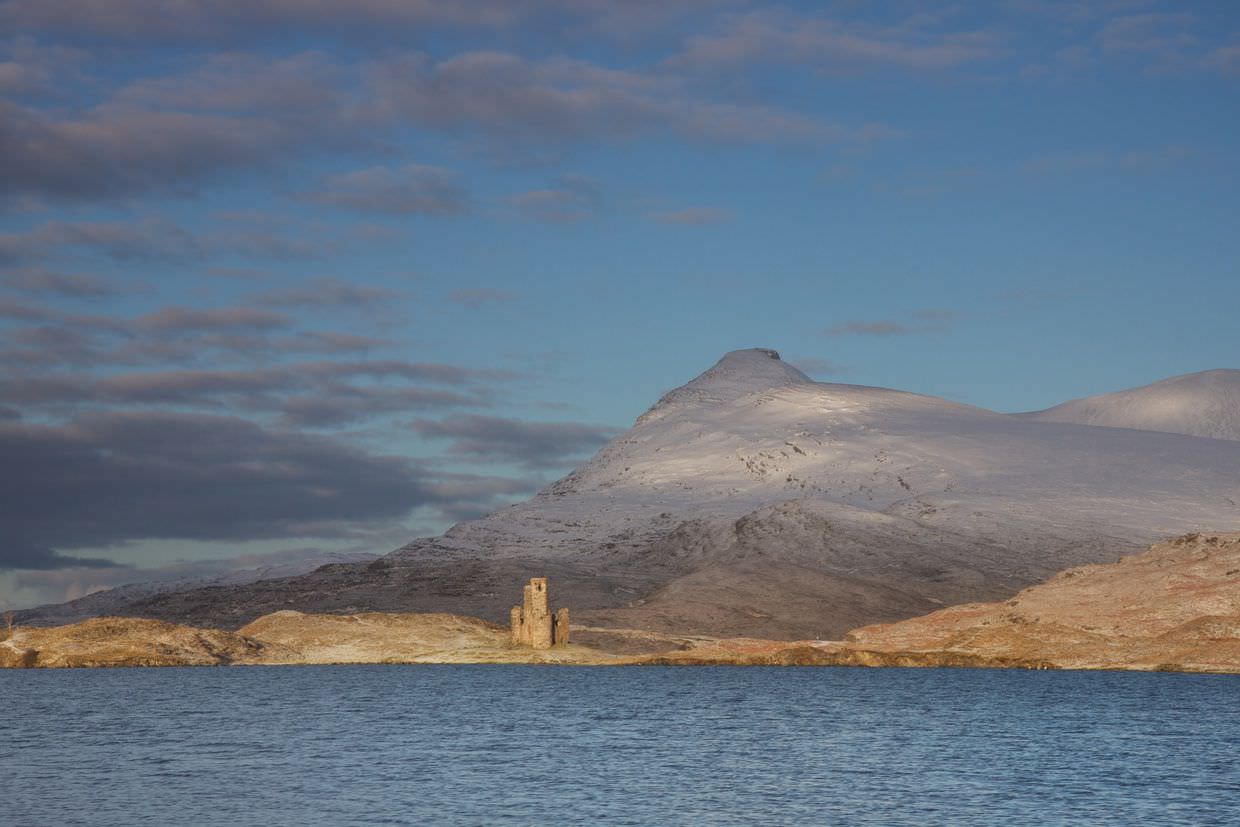
Scots pine and miniature frozen trees
A little further around Loch Assynt we stopped again to photograph some large Scots pine trees that live on a small island, although our focus quickly turned to the frozen water’s edge in front of us where many shrubs had broken through the ice and looked like miniature frozen trees. Even though it was midday, this deep into Winter the light is “productive” all day. From the car we trudged through the snow, being careful not to slip into a hidden stream or the masked edge of the loch; the snow disguised all the traps. Then we had the slight issue of trying to find solid ground for the tripods. We must’ve spent about an hour here, and the golden yellow light didn’t change much in that time. I used a zoom lens with a wide aperture to soften reeds in the foreground and try and pick out the little trees.
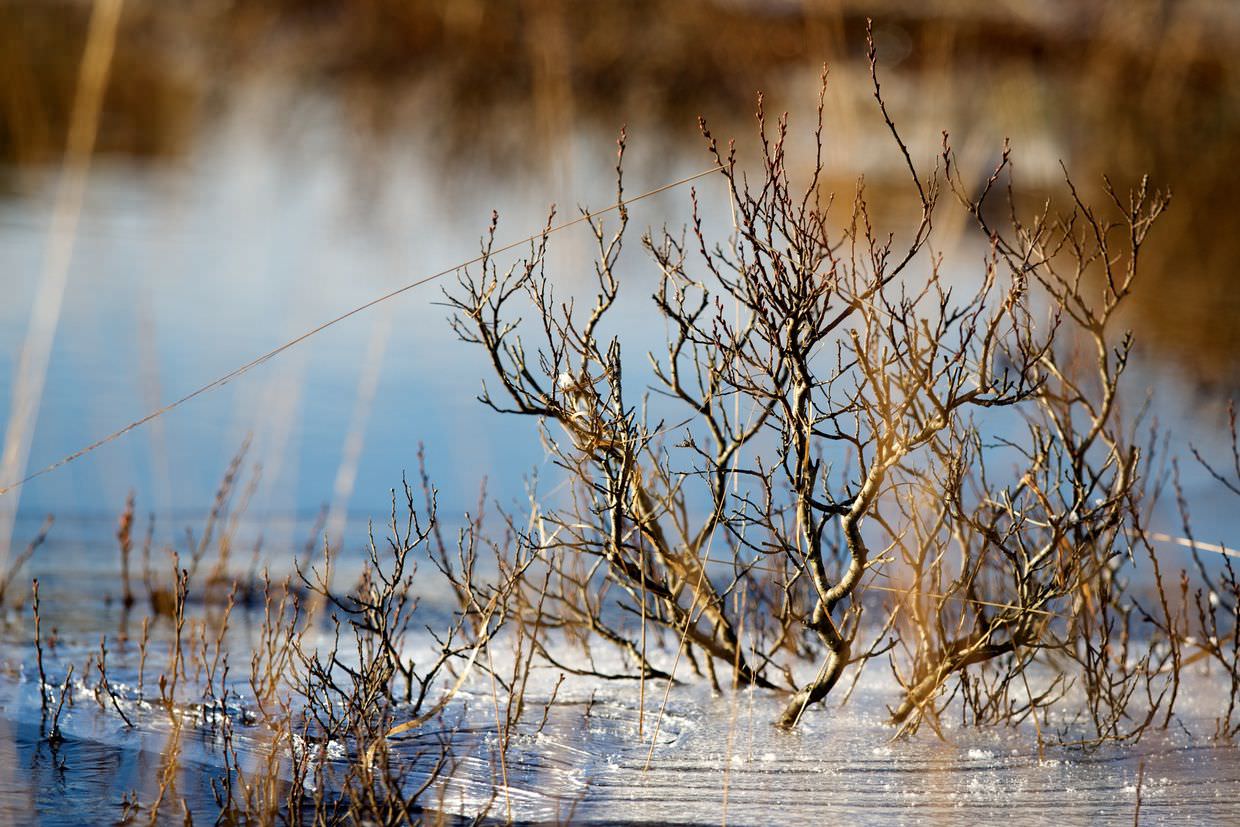
In the cold the one battery we had (the spare had died a few months back) for the old Canon 500D quickly gave up. Ian lent Samantha his Fuji X-T1 mirrorless camera with an 18-55mm lens as an alternative. Sam loved this camera, as each setting seemed to have its own dial and could be instantly set and tweaked, unlike the Canon one which in comparison was a quagmire of menus.
Elphin
Driving through the highland roads, the snow-peaked mountains looked glorious against a blue sky with wispy warm clouds. On route to our planned final stop Ian was looking out for a small building near the roadside that he’d photographed before. It sat on the outskirts of Elphin, a “crofting township”, 15 miles north of Ullapool. It’s really very tiny, and the building itself was practically a hut, with some old billowing curtains. We set out with tripods and filters once again.
From this viewpoint we were high above Cam Loch to the North with Canisp mountain behind it, further west sits the distinctive Suilven mountain that climbs straight up, and west again is the towering Cul Mor mountain – the highest point in Inverpolly.
As we drove past the loch it looked still and was casting a nice reflection, Samantha set off in that direction to photograph it, while Ian and I continued up the road to capture a snowy hut in the late afternoon sun. It sat amidst wintery grasses and a backdrop of snow-peaked mountains. When we arrived everything looked just right; the snow pristine but shallow enough to have texture, the light dazzling, the sky interesting, and this quirky old building made for an interesting foreground. The composition made itself, and both Ian and I setup something similar. When Sam returned she put her tripod further up the hill in a different place altogether and captured her own unique but stunning composition that included both Cul Mor and Suilven peaks.
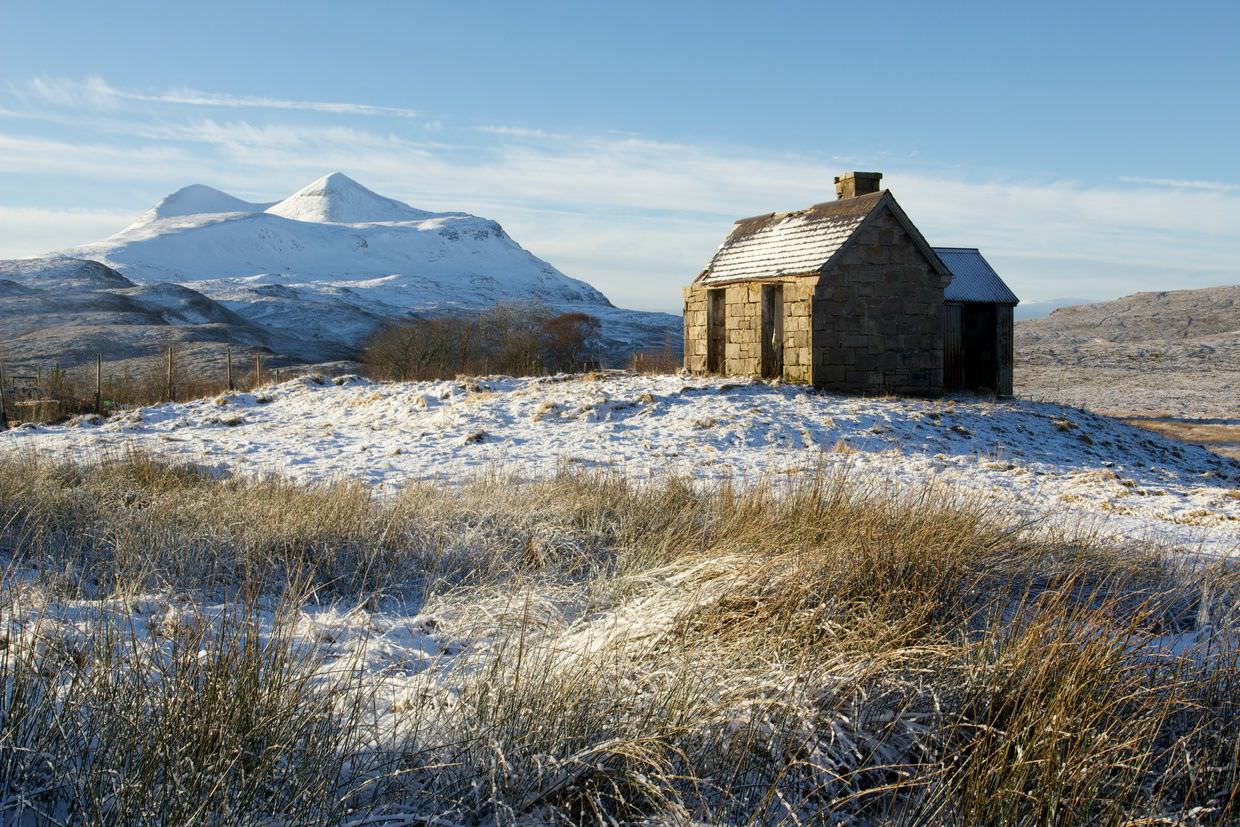
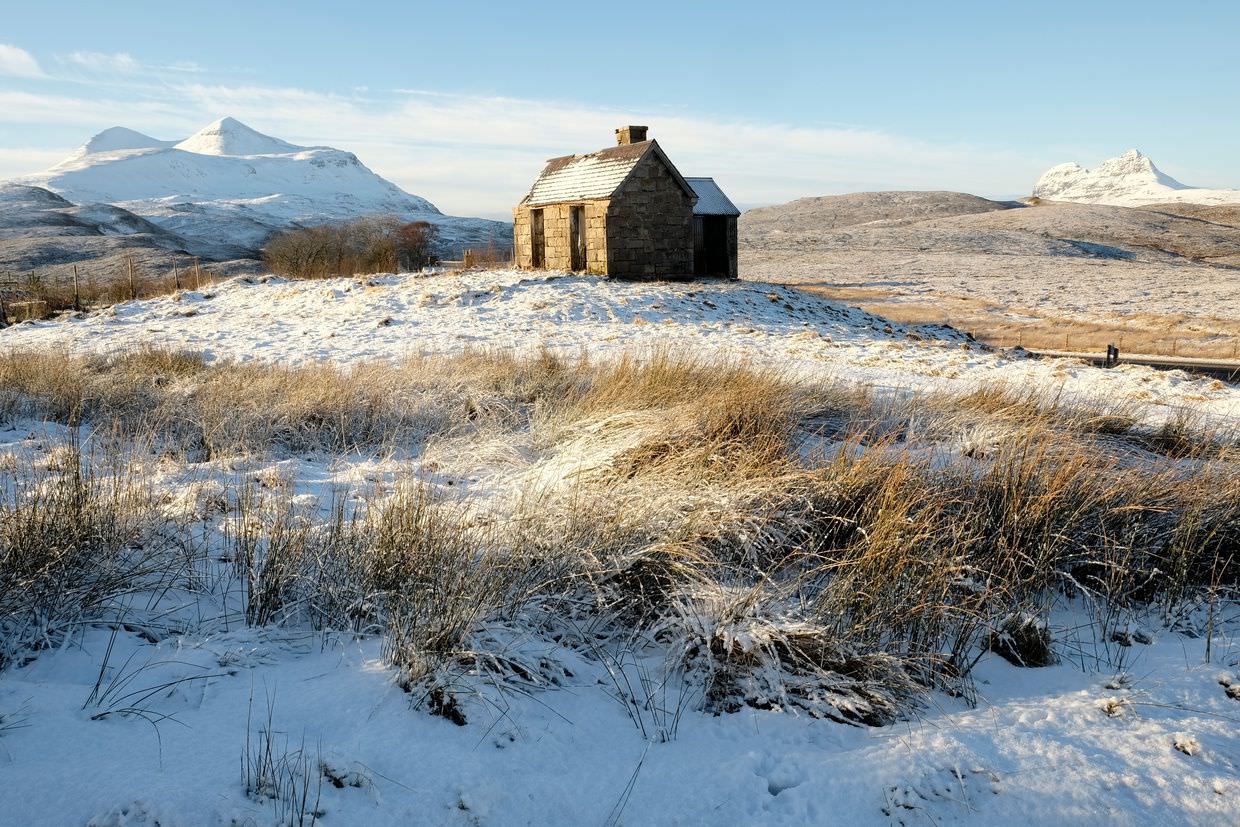
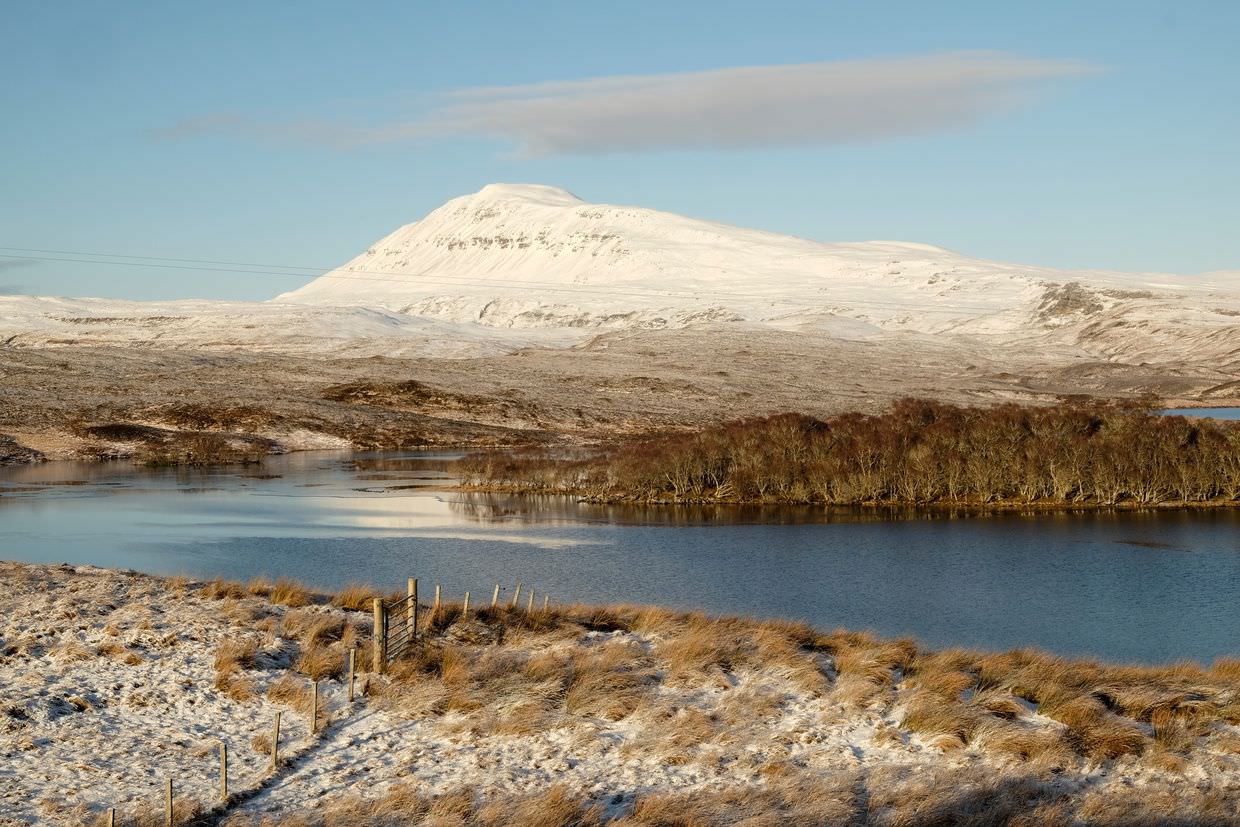
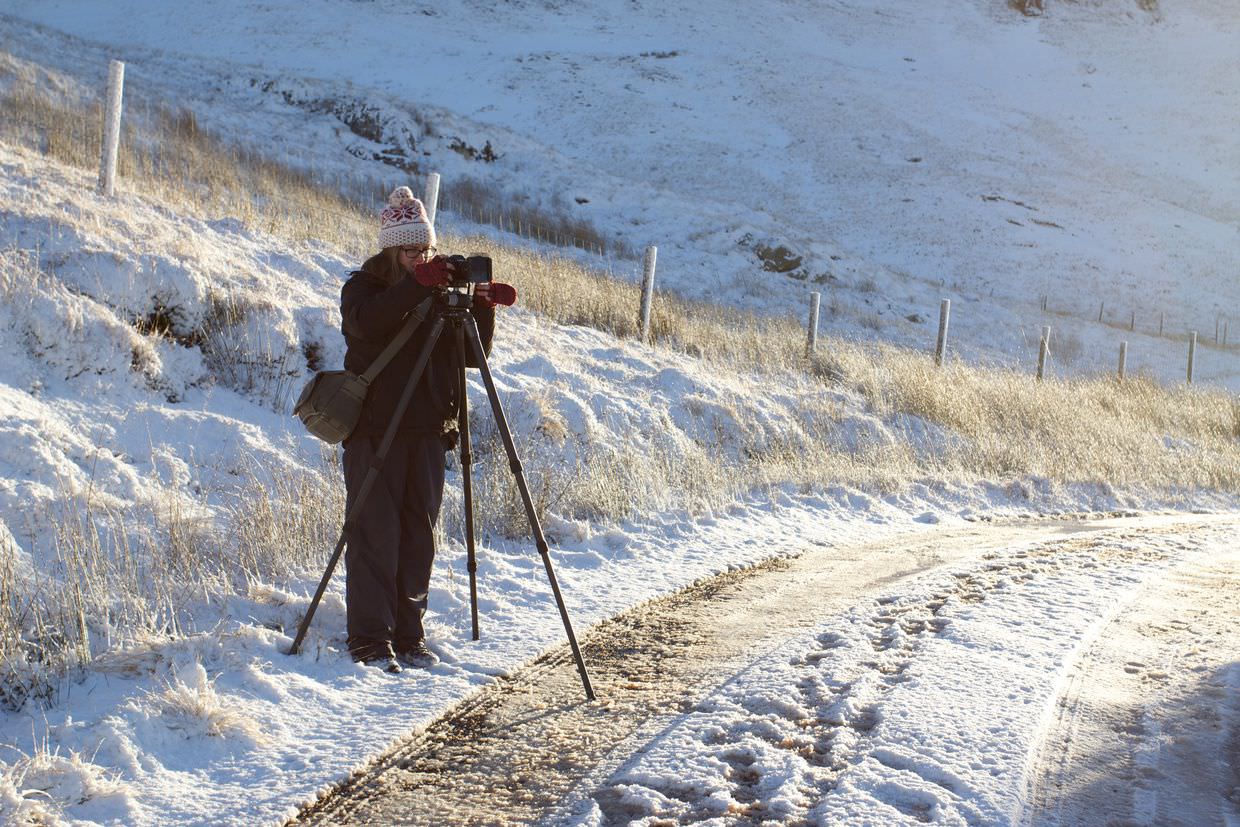
Brae of Achnahaird
Our spot for sunset would be near to yesterday’s, back towards Ullapool then West again to the coast, beyond the kamikaze deer and black sheep to the sand dunes at Brae of Achnahaird. The panorama, “Scotland’s best” from here was one Ian had hoped to show us on Sunday, but it had been overcast and you couldn’t see much of anything. Tonight it was looking superb against a clear blue sky, the mountains lined up in a sweeping vista, climbing up from the sea, like the scaly backbone of an enormous dragon.
The intention was to capture the reflection of these mountains in the pools of water around the sand dunes, against the lovely evening light. As we approached the dunes we found that the pools were frozen solid (despite being on sand), and that some clouds in the West were blocking out the sun’s light. We needed to improvise. We quickly abandoned any attempt at photographing a reflection and first turned to the sand dunes themselves, the bristly grass sticks out from the top like bushy eyebrows and replaced the pools as an interesting foreground.
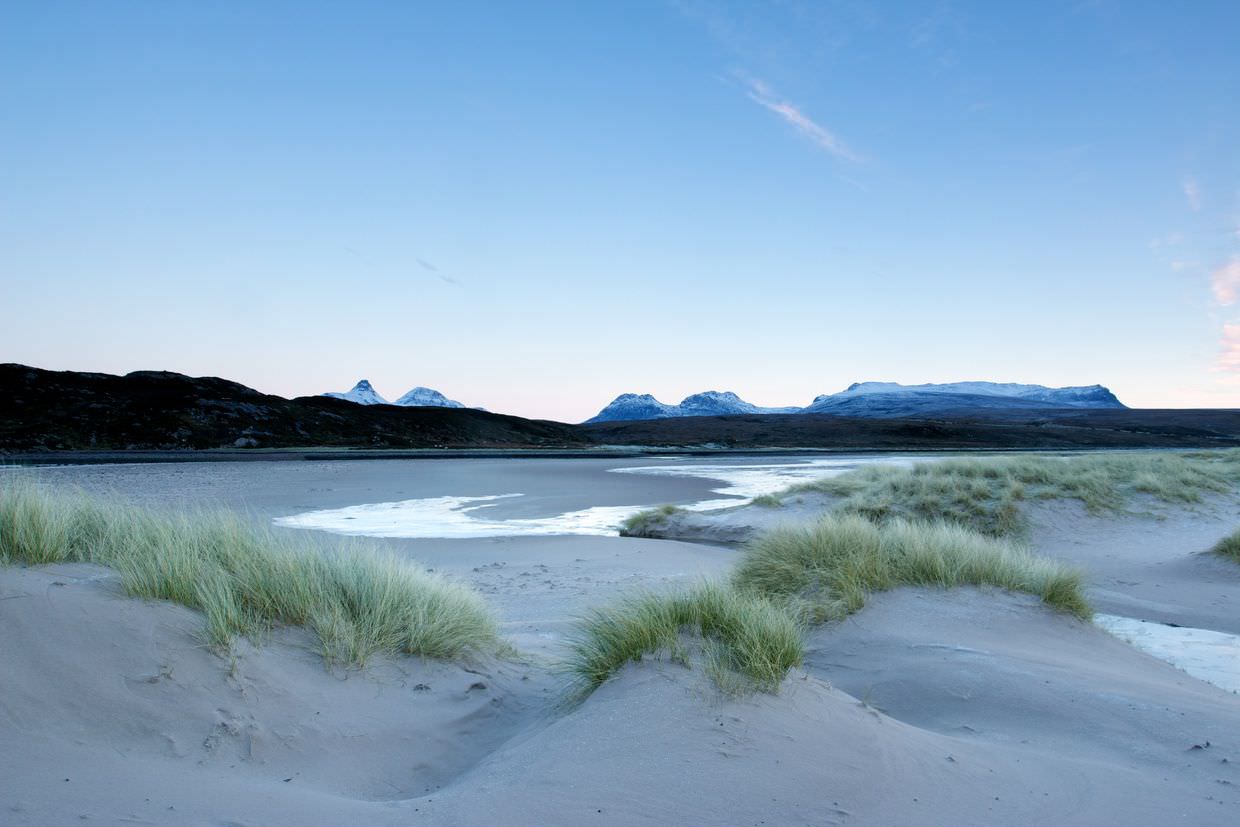
Ice on a beach is a peculiar and rare thing and where the water was shallowest the ice had left interesting mottled patterns and textures in the sand. This became our final subject, and as the night closed in and the temperatures dropped we begun to feel the cold. We noticed that the ice patches had visibly grown whilst we’d been there. Setting the heavy tripods up on the ice was a hoot, with legs sprawled, we could slide the pod about the icy surface and quickly find the composition we wanted; photography on ice.
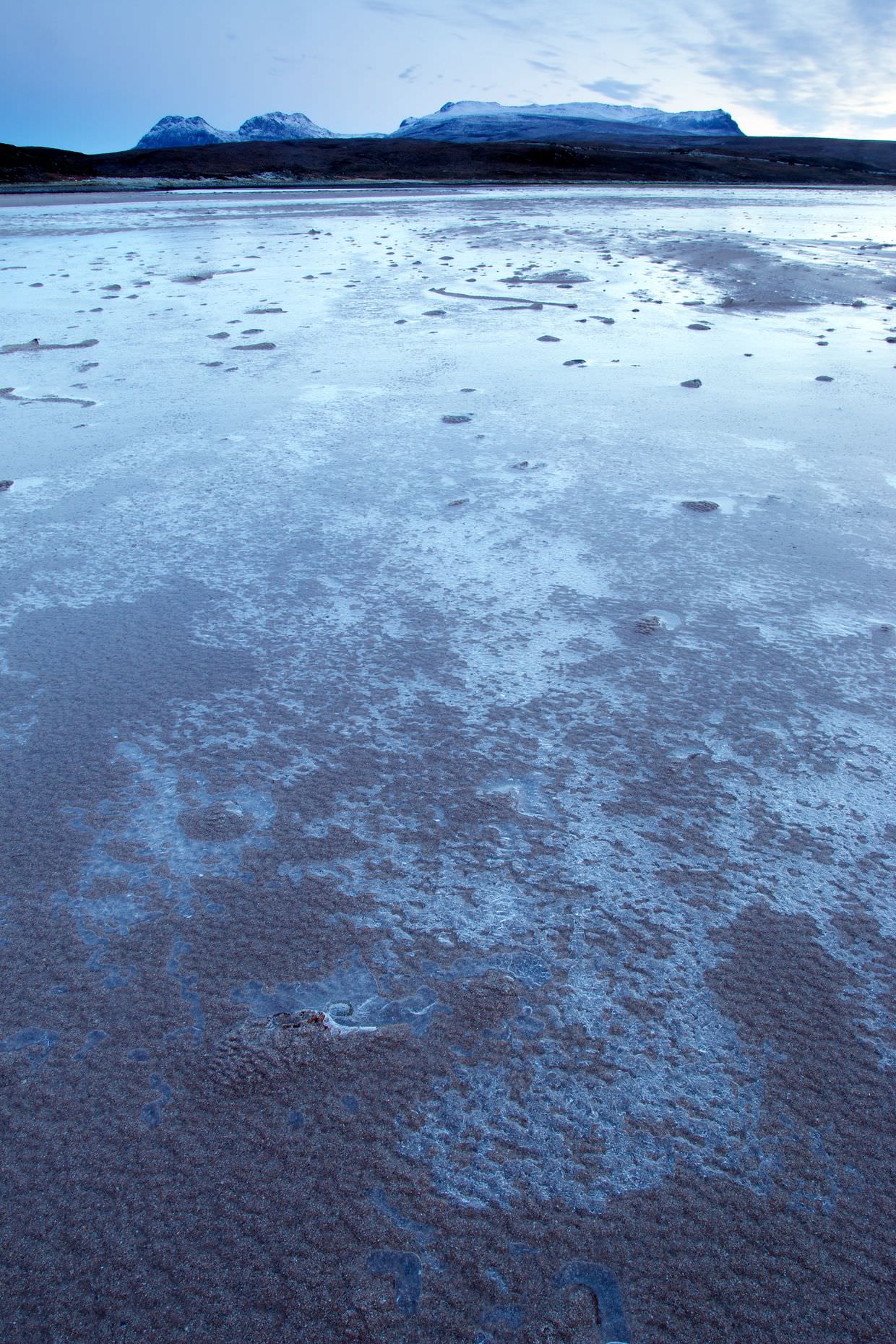
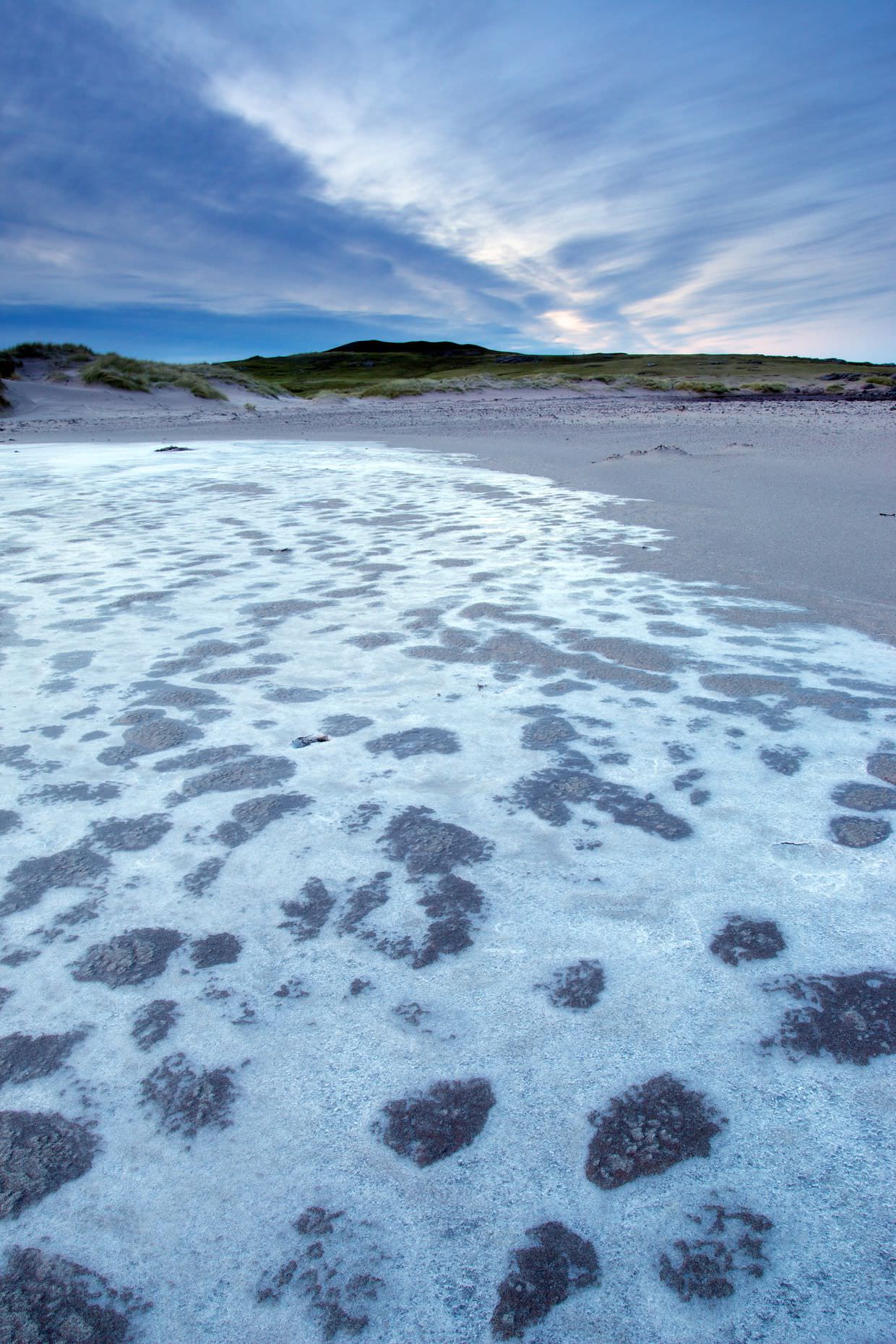
Drive home
And then it was dark and our time photographing the Scottish highlands had come to an end. We had one last cup of tea in the car before setting off across the highlands, back past Ullapool, over the mountains and Loch Glascarnoch (where the car told us it was -13C) and back to Inverness. The journey lasted 2h30 and soon enough we were back at our first hotel, The Glenmoriston Town House.
At the hotel we were happy to return to a normal number of clothing layers, and happy to be in the warmth once again. Sam had also upgraded us to a deluxe river view room, which had an even bigger bed and a “massaging shower”. How luxurious! We’d had a booking at Rocpool in town for another birthday dinner, but we didn’t make it back in time. We weren’t too fussed, a little exhausted we chose to eat at our hotel again, where the Contrast Brasserie turned out to be exquisite. The same music from Saturday night was playing and a friendly Scottish waitress took our orders.
Return to reality
We had a half day before our flight home on Tuesday. We got up late, had a full Scottish breakfast including black pudding, looked through our photos and then returned to the hard grind of managing our imminent flat renovations. But that’s another story. After half a burger each for lunch we took a taxi to Inverness airport and flew back to our home in Brighton, only 4h30 door to door.
Thank you Ian for an exhilarating and illuminating weekend. And thank you Samantha, what a perfect and incredible birthday present. I can’t think of a better way to have begun my thirties.